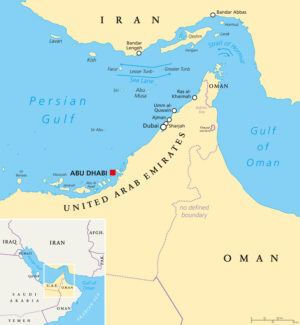The Iranian regime is currently launching drone and missile attacks against Israel in retaliation for the pre-emptive attack on its primary nuclear sites. Iran holds an ace in the hole though, with significant leverage over the Strait of Hormuz, a strategic waterway through which around 20% of the world’s traded oil passes. Its geographic position along the northern coastline gives it a commanding presence, which it has repeatedly used to signal threats of disruption, particularly in response to sanctions or military pressure. Global oil markets are very vulnerable to any action by Iran.
Lloyd’s List estimates that the annual volume of maritime trade transacts through the Strait of Hormuz is approximately US$554 billion (£411bn).
One of the most plausible means Iran could use to create disruption is the deployment of naval mines. Iran possesses a sizeable stockpile of these, and they could be laid covertly in key shipping channels. Even a limited mining operation could wreak havoc.
Iran has both bottom mines from Russia and sophisticated rocket-propelled mines from China in its arsenal. They can be deployed from the air, and they can be laid using ships and submarines.
Clearing the strait would be a painstaking and difficult task, given Iran’s use of “ship counting” and mines, which delay detonation based on how many ships pass over them, and anti-removal fuses that can complicate minesweeping efforts.
Mines are notoriously difficult to detect and neutralise, and the mere possibility of their presence can force tankers to delay transit or reroute. A single damaged vessel would be enough to spook insurers, raise freight costs, and send tremors through global supply chains.
Iran also has a fleet of fast attack craft operated by the Islamic Revolutionary Guard Corps Navy. These small, manoeuvrable boats, often heavily armed, are capable of swarming much larger commercial or military vessels in the confined waters of the strait.
This tactic has been used before to harass, intimidate, or even board and detain ships, allowing Iran to project force in a way that is deniable and difficult to counter without risking escalation.
Complementing these capabilities are Iran’s land-based anti-ship missile systems, which include variants like the Noor and Qader (Ghader). These can be launched from coastal batteries, mobile launchers, or naval platforms and are capable of targeting ships throughout the strait. The presence of such weapons adds a layer of threat to any military or commercial vessel transiting the area, particularly under conditions of heightened tension.
Iran’s submarine fleet, including its midget Ghadir-class submarines, is particularly well suited to the shallow waters of the Gulf. These can lay mines or fire torpedoes while remaining hard to detect. Alongside this, Iran’s growing drone fleet is used to monitor maritime traffic and can be equipped with explosives or used to harass shipping. The combination of unmanned surveillance and asymmetric tactics makes Iranian activity in the region highly unpredictable.
Drone and missile tactics could also be utilised by the Iranians, or foreign-flagged vessels could be hijacked and seized, further causing fear in the markets.
These are still early days in the conflict. The Iranian regime is at a weakened state as their Hezbollah and Syrian allies have been seriously depleted. The West should take heed that a cornered rat can cause a lot of damage.
A huge increase in the oil price will also bolster and enrich Vladimir Putin beyond belief, as most Western countries would be hit by vast inflationary pressure and high crude oil prices.
It is not certain if the Israeli pre-emptive strike will thwart the Iranians from their nuclear weapons programs. The Iranians now have the knowledge and capabilities to make nuclear weapons, and they will simply move their facilities to even more secret locations from now on. The Strait of Hormuz is however a serious strategic weakness and bone of contention with the West and Israel.







